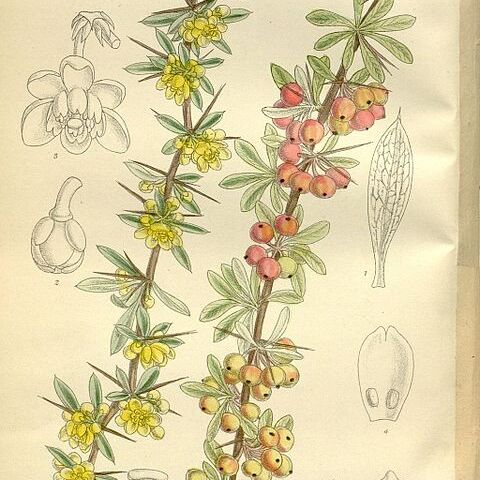Shrubs, semi-evergreen, ca. 1 m tall, with arching branches. Branches brownish gray; shoots dark red, sulcate, scarcely black verruculose; spines 3-fid, sometimes simple or absent, pale yellow or pale purplish red, 1-2 cm, slender. Leaves subsessile; leaf blade abaxially gray, adaxially dark gray-green, obovate or obovate-spatulate or oblanceolate, 6-25 × 2-6 mm, leathery, abaxially often slightly pruinose, with raised reticulate veins, adaxially with conspicuous reticulate veins, base cuneate, margin entire, occasionally 1-or 2-spinulose-serrulate on each side, apex rounded, obtuse or subacute. Inflorescence a fascicle of 4-7 flowers or a 3-7-flowered raceme. Pedicels brownish, 3-7 mm; bractlets ovate. Sepals in 2 whorls; outer sepals ovate, 3-4 × 2-3 mm; inner sepals obovate-orbicular or obovate, 5-5.5 × 3.5-4 mm. Petals obovate, ca. 4 × 2 mm, apex emarginate, with acute lobes. Stamens ca. 3 mm; anther connective slightly prolonged, obtuse. Ovules 3-5. Berry reddish, subglobose, 6-7 × 4-5 mm, slightly pruinose, style persistent. Fl. Jun-Sep, fr. Jan-Feb of following year.
More
A shrub. It loses its leaves in colder places. It grows to 1.5 m high. It spreads with branches arching over and touching the ground. The leaves are small, narrow and without teeth. The tip is rounded. The leaves turn yellow, orange or red. The flowers are yellow. The fruit are pink. The fruit turn red. They are 6 mm across.
The fruit are acidic and can be eaten fresh but are often used in preserves, desserts, pies, chutneys etc. The flowers are eaten as a vegetable.

